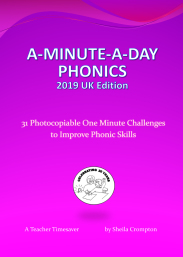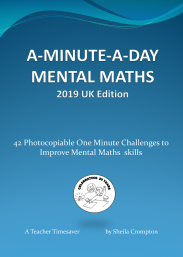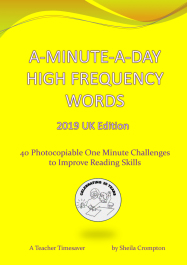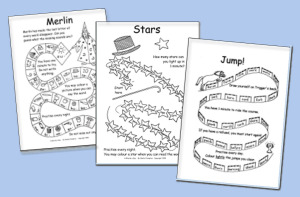
Why 'A Minute A Day'
A 'Precision Teaching' Tool
A-MINUTE-A-DAY has at its roots, a method known as precision teaching, whose value, since its inception in 1964 has become recognised by an ever-increasing number of teachers. As an aid to the development of children's learning, by simultaneous monitoring of speed and accuracy on a daily basis, its success, in both main-stream and special education is indisputable.
The value of precision teaching lies in identifying an area of need for the child, followed by a daily period of teaching, testing and evaluating progress. One could reasonably expect this to take 10-15 minutes of completely undivided attention for a particular child. A short enough period to offer any child, it must be admitted, but when maybe a dozen children within a large class require similar help and encouragement, to a teacher without ancillary help, the task can seem insurmountable. Unless, that is, we can discover a method which enables teachers to offer their pupils systematic practice and monitoring of progress on a daily basis i.e. of retaining the flavour of precision teaching, whilst reducing drastically the amount of teacher involvement.
Easy to provide work at an individual and appropriate level.
With a possible solution in mind, this book is compiled. It is not an attempt to tell teachers what they should teach, or when they should teach it. It simply acknowledges that teachers are busy people, who recognise the need for individual attention for their pupils, but with classes of 30+, often feel unable to fulfil this need.
Encourages parental involvment.
So many teachers battle stoically on, alone, and yet there is a vast and frequently untapped source of support in the form of parents, who are invariably eager and capable of participating in their child's education.
Saves hours of homework preparation and marking
Often, there is insufficient time to set homework on a regular basis for primary levell children, and still less time to check it. If, therefore, there is some way in which teachers could direct parents to an area of need for their child, which they would practise for no more than 10 minutes a night, all that is required of the teacher, is a minute a day to monitor the child's progress.
FUN - Yet challenging. Every child can enjoy success.
Parents want their children to learn, so let us show them how they can help, but, LET IT BE FUN……..not with tedious lists, but with games. Above all, let us ensure that homework at primary level is a shared experience for parent and child.
Improvement is measurable and easily understood by the child.
Children love competition - provided that the pressure is not too great. Let them compete against themselves. If they can answer six questions one night, make sure they can answer eight the next, and so on…It does not matter where you begin, it's how much you improve that counts. Often the slowest children are able to enjoy the most success, because they have the room for the greatest improvement.
Games which can involve the whole family.
Sometimes a group or class competition can be healthy. Many children also enjoy competing against their own family - They are always delighted to beat their own parents! First be certain that the child has the skill, but the emphasis is again on the greatest improvement.
Speed plus accuracy equals fluency.
Each game requires the child to answer thirty questions within one minute. This gives adequate opportunity for accurate responses. There is little value in encouraging speed at the expense of accuracy. As the child becomes more skilful, and the first goal is achieved, the time limit may be reduced. For many of the games, a time limit of thirty seconds should not be beyond the ability of the average child.
Blank games to support further Maths and Reading work
Included at the end of each book are three content free games, which may be used, in the case of A-MINUTE-A DAY MATHS to create additional mental maths questions, or in the case of A-MINUTE-A DAY PHONICS, for further phonic work or for sight vocabulary. When used for the latter i.e. when phonically unrelated words are to be learnt, it may be wise to limit the number of new words to suit the ability of the individual child, and to use the remaining spaces to repeat and therefore reinforce those words which offer most difficulty.




